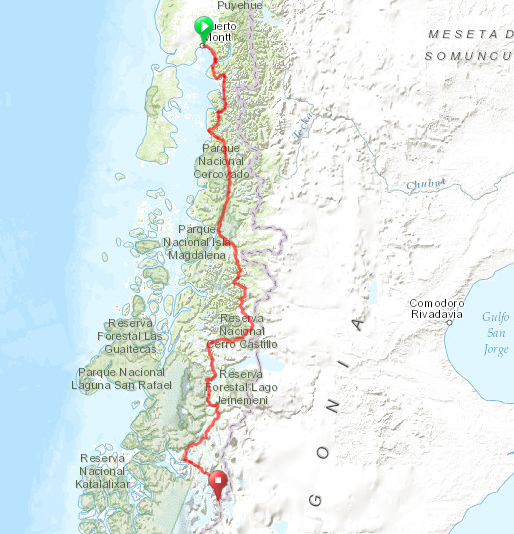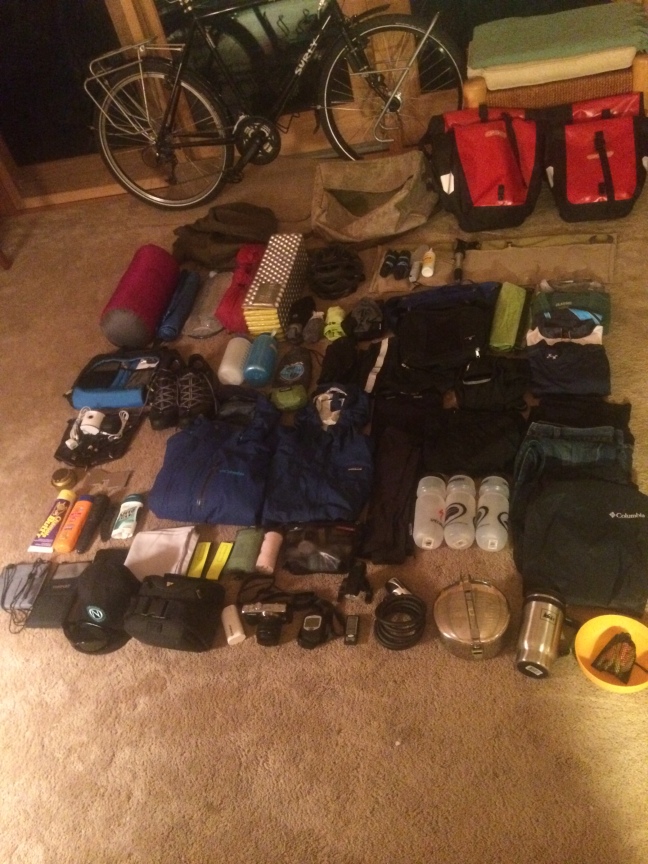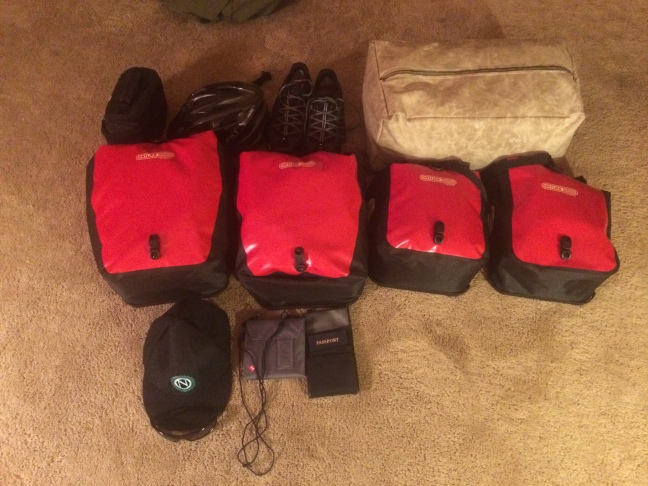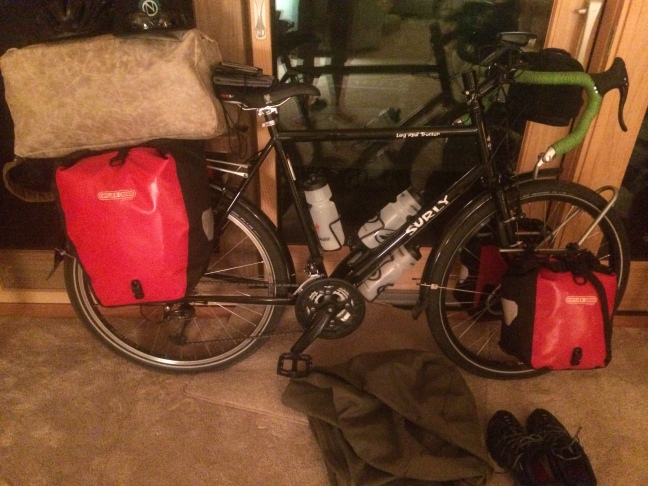I’m off to Chilean Patagonia next Wednesday. My bike is in the process of being boxed up and my bags have been packed in a standard issue green canvas military bag. A bike box is frustratingly expensive to take on the small planes out of Eugene, so I’m driving to San Francisco to fly out of there. I’m flying through Toronto, to Santiago, and then on to Puerto Montt at the start of the Carretera Austral. I should be there by the night of the 17th local time if everything goes according to plan. I’ve been composing this post for about two weeks now, and it gives some more details about the route, info about my gear, and the motivation for my trip. Over this summer I’ve visited tons of touring blogs, and they were all helpful in giving me gear and route suggestions. If someone who doesn’t know who I am comes similarly comes across this blog in the future, I hope this post can be as helpful for you as the others were for me. So without further ado, here’s for you, future Google searchers:
Carretera Austral. Carretera Austral cycling tour. Carretera Austral September weather. Chilean Patagonia cycling tour. Puerto Montt to Ushuaia cycling.
The Route, Part One
The Carretera Austral is a 1200km long, mostly gravel road that was built by Augusto Pinochet in the 1970’s. On Google Maps and elsewhere, it is labeled as Ruta 7. It connects the most remote parts of Chile, the southern Los Lagos and Aysén regions, to the rest of the country. It is incredibly remote, with only about 100,000 people living along the entirety of the route, and almost half of these live in the town of Coyhaique about halfway down.
This is part one of my trip. I have some freedom after I’ve done this. After I reach Villa O’Higgins at the end of the Carretera, there are some different directions I could go. The only certainty is that I have to cross into Argentina and continue on Ruta 40 in Argentinian Patagonia. I’d like to stop at Torres del Paine NP in Argentina, and then continue south. I could go all the way to the end of South America to Ushuaia, adding another 800km to the trip.
As I’ve mentioned, I have a lot of free time. I’ve got a one-way ticket, and about 3-4 months before I have somewhere to be. Puerto Montt to Ushuaia won’t take that long, so I’d love to go to the north of Chile after that and do the Andes or parts of the Atacama desert. But I haven’t made up my mind yet and there’s certainly no need to commit to anything yet…
Motivation
I’m very fortunate to have access to resources that allow me to take a trip like this at my age. A wonderful family, the most incredible friends in the world and very importantly the access to the financial resources to make this possible. I also recognize that I’m in an important transitionary period from childhood to adulthood, and I’d rather not waste my time at this age doing something I don’t enjoy, doesn’t challenge me, or doesn’t let me learn how to do new things. So I guess I’m doing this trip simply because it’s something that I think I will enjoy, know will challenge me, and hopefully will let me learn something. That, and, in the immortal words of George Mallory:
Because it’s there.
Time of Year
The best time to go to Chilean Patagonia is during the Summer months of November-February. During those months, there is the least amount of rain and the temperatures are relatively mild. However, these are also the most crowded tourist months, and so I have decided to go starting during the spring shoulder months of September and October. It will rain a lot, but I’m bringing tons of waterproof gear. Nevertheless, it should be warming up throughout my trip and moving into the summer months.
One of the ferries that people usually take from Villa O’Higgins into Argentina will not be running until November, so I’m going to have to rely on a back route and a sort of sketchy border crossing at the Rio Mayer pass. Rumors are that the sheep bridges have recently collapsed, so we’ll see if it’s even possible.
Packing
I have put a lot of effort into packing for this trip. Prior to this summer, my backpacking supplies were limited at best and my bike touring supplies were nonexistent. My only bike was a 2007 Trek 2100 carbon frame road bike, which has been an absolute joy to own since I got it about 6 years ago. Unfortunately, it’s not suitable to touring, as it has no mounts for racks or bags. It was a Miata, and I needed a Jeep. So, new touring bike, new bags, new tent, new jacket (college was outside Los Angeles, so my winter clothes were lacking), new racks, etc. Basically, most things are new. Below, with a few things missing, is my setup.
Some highlights (not everything, and I’ll be adding thoughts and more details to this list as I go, just in case someone comes across this list in the future):
- Bike
- Surly Long Haul Trucker (Thanks to Paul’s Bicycle Way of Life in Eugene for the build!)
- Tubus Tara and Logo Racks
- Bags
- Ortlieb Back/Front Roller Classic panniers (top right)
- Frame bag (top center, homemade)
- Topeak handlebar bag (bottom left)
- Eagle peak inner bags (the Orlieb panniers don’t have inner pockets)
- Camping Gear
- Tent: MSR Hubba NX1
- Sleeping Bag: Kelty Cosmic 20
- Pad: Thermarest
- Stove: Trangia multifuel stove and stand
- MSR pot
- Steripen and backup iodine tablets
- Clothes
- Colombia warm jacket
- Patagonia rain shell
- Arm/Leg warmers
- Padded cycling tights
- Padded cycling shorts
- Collared short sleeve shirt, t-shirt, cycling jersey
- Rain pants, sweat pants, jeans
- Underarmor base layer
- Ninkasi Brewery hat
- North Face waterproof shoes
- Waterproof shoe covers
- Sun hat
- Water resistant gloves
- Cycling accessories/tools
- Tool rolls with tons of different bike tools and spare parts (top right, homemade)
- Curly cable lock
- Waterbottle cages and bottles
- 3L Platypus water bag/bite straw
- Wallets, cash, ID, passport, and copies of all documents.
- Toiletries
- Chamois chafing cream
- Sunscreen
- Dr. Bronner’s organic soap bar and rag
- Medical wrap
- Immodium, Ibuprofen, Benadryl, other drugs
- Electronics
- Macbook Air
- External Drive
- Kindle
- Unlocked iPhone (bluetooths with GPS unit) with SIM card
- Cables, cables, and more cables
- Panasonic DMC-GF6 micro 4/3 camera
- Bad Elf Pro GPS (bluetooths to offline phone maps, tracks route)
- 6000 mAh usb charger battery
- Shimano NX-72 Hub Dynamo (really cool 5V generator on bike hub)
- Mavic Cyclometer
Now for packing all of this gear into the bike bags. Below is all of the stuff packed into secondary Eagle Creek bags. The Ortlieb panniers unfortunately do not have dividers or inner pockets, so I’m using a bunch of loose bags to pack my stuff.
Next, all bags packed into panniers, just to be mounted on the bike. The homemade rack top bag was custom fit to hold my pad, sleeping bag, tent, and water.
Next, everything gets packed on the bike, but not affixed. I have bungee cords that hold the rack top bag on.
That’s all for now. Next week, I’ll be writing from southern Chile!






Hey Bryan ,
I am considering biking the Carretera Austral this September, and I was wondering how your trip was?
Would you recommend it or was it to wet and cold?
LikeLike
I would very much recommend it, even in September. It’s really cold and rainy in spring, but I’d argue that it is a much more intense experience to be there at that time. There was nobody along the route. No cyclists, no motorcyclists. It gets very popular in the summer, but I was literally the first cyclist through for the season and got a warm reaction from pretty much everyone local I met. If you’re looking for absolute solitude for the time you do it, then I would highly suggest the springtime. In fact, if I were to do it again, I’d do it in springtime.
I can’t underscore it enough, though: It is rainy and cold. And very windy at times. The roads get muddy. Also, the ferry at Villa O’Higgins at the end doesn’t run until November, so you may have to do an alternate route out.
LikeLike